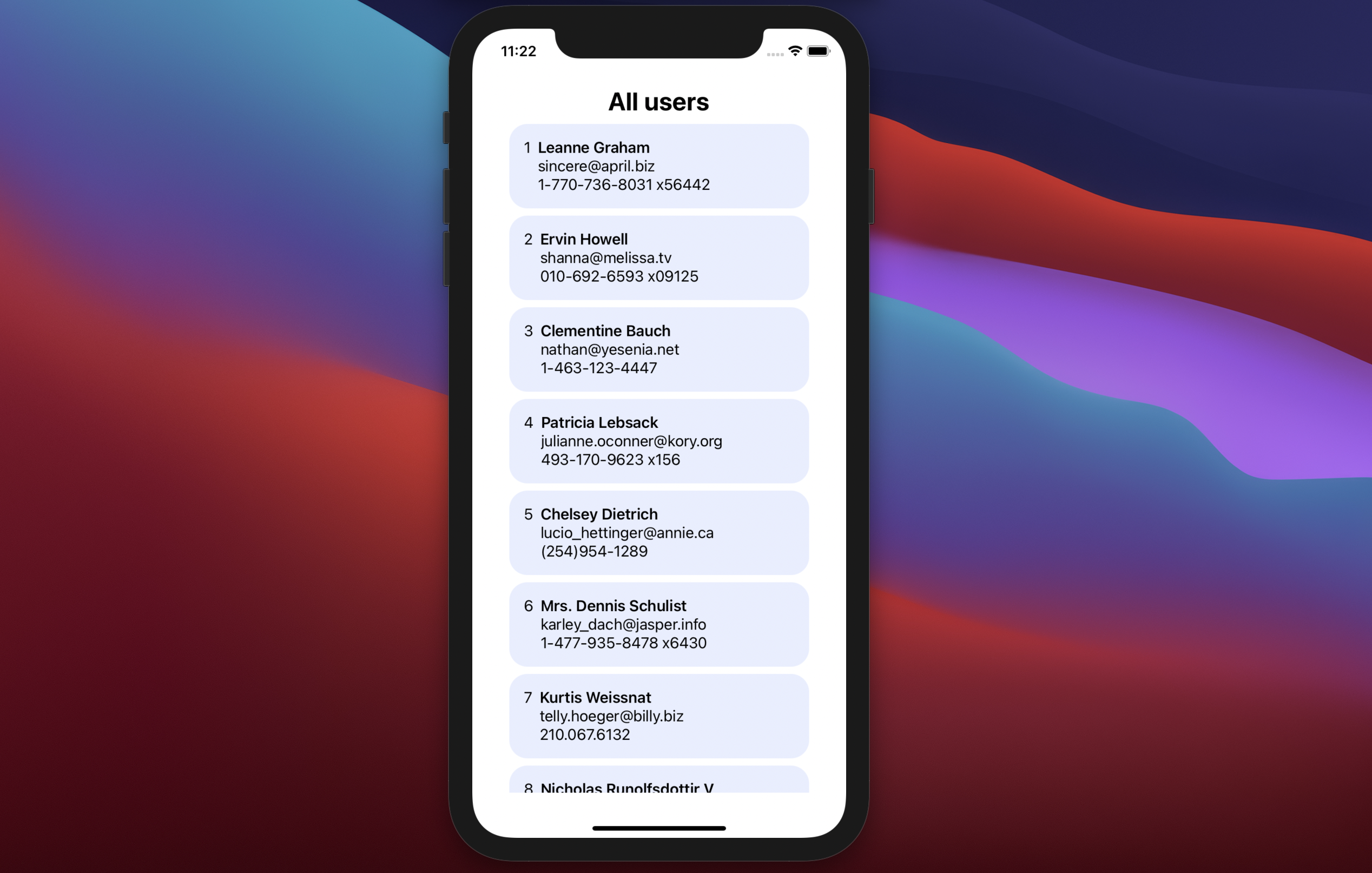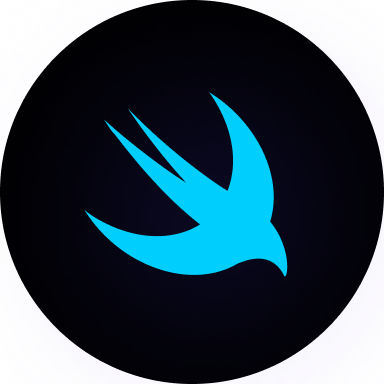HTTP Request
Add to favorites
Create an HTTP Get Request to fetch data from an API
SwiftUI Advanced Handbook
1
Firebase Auth
8:18
2
Read from Firestore
8:01
3
Write to Firestore
5:35
4
Join an Array of Strings
3:33
5
Data from JSON
5:08
6
HTTP Request
6:31
7
WKWebView
5:25
8
Code Highlighting in a WebView
5:11
9
Test for Production in the Simulator
1:43
10
Debug Performance in a WebView
1:57
11
Debug a Crash Log
2:22
12
Simulate a Bad Network
2:11
13
Archive a Build in Xcode
1:28
14
Apollo GraphQL Part I
6:21
15
Apollo GraphQL Part 2
6:43
16
Apollo GraphQL Part 3
5:08
17
Configuration Files in Xcode
4:35
18
App Review
5:43
19
ImagePicker
5:06
20
Compress a UIImage
3:32
21
Firebase Storage
11:11
22
Search Feature
9:13
23
Push Notifications Part 1
5:59
24
Push Notifications Part 2
6:30
25
Push Notifications Part 3
6:13
26
Network Connection
6:49
27
Download Files Locally Part 1
6:05
28
Download Files Locally Part 2
6:02
29
Offline Data with Realm
10:20
30
HTTP Request with Async Await
6:11
31
Xcode Cloud
9:23
32
SceneStorage and TabView
3:52
33
Network Connection Observer
4:37
34
Apollo GraphQL Caching
9:42
35
Create a model from an API response
5:37
36
Multiple type variables in Swift
4:23
37
Parsing Data with SwiftyJSON
9:36
38
ShazamKit
12:38
39
Firebase Remote Config
9:05
Network class
We'll need to create a class that conforms to the ObservableObject protocol. By conforming our class to an ObservableObject, the changes in the class will automatically be reflected in our View. Let's create a Network.swift file, in which we will call the API.
// Network.swift
import SwiftUI
class Network: ObservableObject {
}User model
Next, we'll create a User model. By doing so, we can conform our variables to a User data type. The model will also allow us to decode the JSON we will get from the API into a User data type. Moreover, we'll be able to call the user's name by simply writing user.name.
First, we'll need to know how the JSON data we get is structured. We can head over to https://jsonplaceholder.typicode.com/users to see how it is structured:

As you can see in the image above, the JSON is an array of objects. Each object represents a user, and it contains many key-value pairs.
Back in our project, we'll need to create a struct that contains all of these key-value pairs. Luckily, I already created the User model for you, below. Simply create a new User.swift file, and paste the following code:
// User.swift
import Foundation
struct User: Identifiable, Decodable {
var id: Int
var name: String
var username: String
var email: String
var address: Address
var phone: String
var website: String
var company: Company
struct Address: Decodable {
var street: String
var suite: String
var city: String
var zipcode: String
var geo: Geo
struct Geo: Decodable {
var lat: String
var lng: String
}
}
struct Company: Decodable {
var name: String
var catchPhrase: String
var bs: String
}
}This model conforms to the Identifiable and Decodable protocols. Identifiable means that each item has a unique ID. Decodable means that it can be decoded - for example, we can transform a JSON object into this data model.
@Published variable
Back in Network.swift, we'll need to create a @Published users variable inside of the class. The variable's type will be an array of Users. We'll initialize the variable with an empty array to begin with.
// Network.swift
class Network: ObservableObject {
@Published var users: [User] = []
}Get request
Now, we need to create our getUsers function to fetch the users from the API. Create the function inside of the Network class.
// Network.swift
func getUsers() {
guard let url = URL(string: "https://jsonplaceholder.typicode.com/users") else { fatalError("Missing URL") }
let urlRequest = URLRequest(url: url)
let dataTask = URLSession.shared.dataTask(with: urlRequest) { (data, response, error) in
if let error = error {
print("Request error: ", error)
return
}
guard let response = response as? HTTPURLResponse else { return }
if response.statusCode == 200 {
guard let data = data else { return }
DispatchQueue.main.async {
do {
let decodedUsers = try JSONDecoder().decode([User].self, from: data)
self.users = decodedUsers
} catch let error {
print("Error decoding: ", error)
}
}
}
}
dataTask.resume()
}In the code above, we are making sure that we have a URL before running the next line of code. With this URL, we are creating a URLRequest, and passing it to our dataTask.
We are making sure that there's no error and that we do get a response back. If the response is 200 Okay, we double check that we have data.
We then decode the data we get, which is JSON format, using JSONDecoder, and decode the data into an array of Users. Once the decoding is done, we assign it to the users variable we defined at the top of the class.
Finally, we are resuming our dataTask with dataTask.resume().
Create an environmentObject
Now that our function is created, we need to add our Network class as an EnvironmentObject in the ProjectNameApp.swift file.
// ProjectNameApp.swift
import SwiftUI
@main
struct ProjectNameApp: App {
var network = Network()
var body: some Scene {
WindowGroup {
ContentView()
.environmentObject(network)
}
}
}In ContentView, add Network as an EnvironmentObject.
// ContentView.swift
struct ContentView: View {
@EnvironmentObject var network: Network
// More code...
}To make the preview work, remember to add the environmentObject in your ContentView's preview as well, as the preview is a different entity from the App:
// ContentView.swift
struct ContentView_Previews: PreviewProvider {
static var previews: some View {
ContentView()
.environmentObject(Network())
}
}Call getUsers
In your body, create a ScrollView and onAppear of it, we'll call our getUsers function:
// ContentView.swift
var body: some View {
ScrollView {
Text("All users")
.font(.title).bold()
}
.onAppear {
network.getUsers()
}
}Iterate over users
Then, simply iterate over network.users. We'll display each user's ID, name, email and phone.
VStack(alignment: .leading) {
ForEach(network.users) { user in
HStack(alignment:.top) {
Text("\(user.id)")
VStack(alignment: .leading) {
Text(user.name)
.bold()
Text(user.email.lowercased())
Text(user.phone)
}
}
.frame(width: 300, alignment: .leading)
.padding()
.background(Color(#colorLiteral(red: 0.6667672396, green: 0.7527905703, blue: 1, alpha: 0.2662717301)))
.cornerRadius(20)
}
}If you're using the Preview, remember to press play to fetch the data from the API. The results should instantly appear if you're using the Simulator.
Final code
This is the final code for the Network class:
import SwiftUI
class Network: ObservableObject {
@Published var users: [User] = []
func getUsers() {
guard let url = URL(string: "https://jsonplaceholder.typicode.com/users") else { fatalError("Missing URL") }
let urlRequest = URLRequest(url: url)
let dataTask = URLSession.shared.dataTask(with: urlRequest) { (data, response, error) in
if let error = error {
print("Request error: ", error)
return
}
guard let response = response as? HTTPURLResponse else { return }
if response.statusCode == 200 {
guard let data = data else { return }
DispatchQueue.main.async {
do {
let decodedUsers = try JSONDecoder().decode([User].self, from: data)
self.users = decodedUsers
} catch let error {
print("Error decoding: ", error)
}
}
}
}
dataTask.resume()
}
}This is the final code for ContentView:
import SwiftUI
struct ContentView: View {
@EnvironmentObject var network: Network
var body: some View {
ScrollView {
Text("All users")
.font(.title)
.bold()
VStack(alignment: .leading) {
ForEach(network.users) { user in
HStack(alignment:.top) {
Text("\(user.id)")
VStack(alignment: .leading) {
Text(user.name)
.bold()
Text(user.email.lowercased())
Text(user.phone)
}
}
.frame(width: 300, alignment: .leading)
.padding()
.background(Color(#colorLiteral(red: 0.6667672396, green: 0.7527905703, blue: 1, alpha: 0.2662717301)))
.cornerRadius(20)
}
}
}
.padding(.vertical)
.onAppear {
network.getUsers()
}
}
}
struct ContentView_Previews: PreviewProvider {
static var previews: some View {
ContentView()
.environmentObject(Network())
}
}This is the final result in the Simulator:

Learn with videos and source files. Available to Pro subscribers only.
Purchase includes access to 50+ courses, 320+ premium tutorials, 300+ hours of videos, source files and certificates.
Templates and source code
Download source files
Download the videos and assets to refer and learn offline without interuption.
Design template
Source code for all sections
Video files, ePub and subtitles
Videos
Assets
ePub
Subtitles
1
Firebase Auth
How to install Firebase authentification to your Xcode project
8:18
2
Read from Firestore
Install Cloud Firestore in your application to fetch and read data from a collection
8:01
3
Write to Firestore
Save the data users input in your application in a Firestore collection
5:35
4
Join an Array of Strings
Turn your array into a serialized String
3:33
5
Data from JSON
Load data from a JSON file into your SwiftUI application
5:08
6
HTTP Request
Create an HTTP Get Request to fetch data from an API
6:31
7
WKWebView
Integrate an HTML page into your SwiftUI application using WKWebView and by converting Markdown into HTML
5:25
8
Code Highlighting in a WebView
Use Highlight.js to convert your code blocks into beautiful highlighted code in a WebView
5:11
9
Test for Production in the Simulator
Build your app on Release scheme to test for production
1:43
10
Debug Performance in a WebView
Enable Safari's WebInspector to debug the performance of a WebView in your application
1:57
11
Debug a Crash Log
Learn how to debug a crash log from App Store Connect in Xcode
2:22
12
Simulate a Bad Network
Test your SwiftUI application by simulating a bad network connection with Network Link Conditionner
2:11
13
Archive a Build in Xcode
Archive a build for beta testing or to release in the App Store
1:28
14
Apollo GraphQL Part I
Install Apollo GraphQL in your project to fetch data from an API
6:21
15
Apollo GraphQL Part 2
Make a network call to fetch your data and process it into your own data type
6:43
16
Apollo GraphQL Part 3
Display the data fetched with Apollo GraphQL in your View
5:08
17
Configuration Files in Xcode
Create configuration files and add variables depending on the environment - development or production
4:35
18
App Review
Request an app review from your user for the AppStore
5:43
19
ImagePicker
Create an ImagePicker to choose a photo from the library or take a photo from the camera
5:06
20
Compress a UIImage
Compress a UIImage by converting it to JPEG, reducing its size and quality
3:32
21
Firebase Storage
Upload, delete and list files in Firebase Storage
11:11
22
Search Feature
Implement a search feature to filter through your content in your SwiftUI application
9:13
23
Push Notifications Part 1
Set up Firebase Cloud Messaging as a provider server to send push notifications to your users
5:59
24
Push Notifications Part 2
Create an AppDelegate to ask permission to send push notifications using Apple Push Notifications service and Firebase Cloud Messaging
6:30
25
Push Notifications Part 3
Tie everything together and test your push notifications feature in production
6:13
26
Network Connection
Verify the network connection of your user to perform tasks depending on their network's reachability
6:49
27
Download Files Locally Part 1
Download videos and files locally so users can watch them offline
6:05
28
Download Files Locally Part 2
Learn how to use the DownloadManager class in your views for offline video viewing
6:02
29
Offline Data with Realm
Save your SwiftUI data into a Realm so users can access them offline
10:20
30
HTTP Request with Async Await
Create an HTTP get request function using async await
6:11
31
Xcode Cloud
Automate workflows with Xcode Cloud
9:23
32
SceneStorage and TabView
Use @SceneStorage with TabView for better user experience on iPad
3:52
33
Network Connection Observer
Observe the network connection state using NWPathMonitor
4:37
34
Apollo GraphQL Caching
Cache data for offline availability with Apollo GraphQL
9:42
35
Create a model from an API response
Learn how to create a SwiftUI model out of the response body of an API
5:37
36
Multiple type variables in Swift
Make your models conform to the same protocol to create multiple type variables
4:23
37
Parsing Data with SwiftyJSON
Make API calls and easily parse data with this JSON package
9:36
38
ShazamKit
Build a simple Shazam clone and perform music recognition
12:38
39
Firebase Remote Config
Deliver changes to your app on the fly remotely
9:05
Meet the instructor
We all try to be consistent with our way of teaching step-by-step, providing source files and prioritizing design in our courses.
Stephanie Diep
iOS and Web developer
Developing web and mobile applications while learning new techniques everyday
7 courses - 36 hours

Build Quick Apps with SwiftUI
Apply your Swift and SwiftUI knowledge by building real, quick and various applications from scratch
11 hrs

Advanced React Hooks Handbook
An extensive series of tutorials covering advanced topics related to React hooks, with a main focus on backend and logic to take your React skills to the next level
3 hrs

SwiftUI Concurrency
Concurrency, swipe actions, search feature, AttributedStrings and accessibility were concepts discussed at WWDC21. This course explores all these topics, in addition to data hosting in Contentful and data fetching using Apollo GraphQL
3 hrs

SwiftUI Combine and Data
Learn about Combine, the MVVM architecture, data, notifications and performance hands-on by creating a beautiful SwiftUI application
3 hrs

SwiftUI Advanced Handbook
An extensive series of tutorials covering advanced topics related to SwiftUI, with a main focus on backend and logic to take your SwiftUI skills to the next level
4 hrs

React Hooks Handbook
An exhaustive catalog of React tutorials covering hooks, styling and some more advanced topics
5 hrs

SwiftUI Handbook
A comprehensive series of tutorials covering Xcode, SwiftUI and all the layout and development techniques
7 hrs
